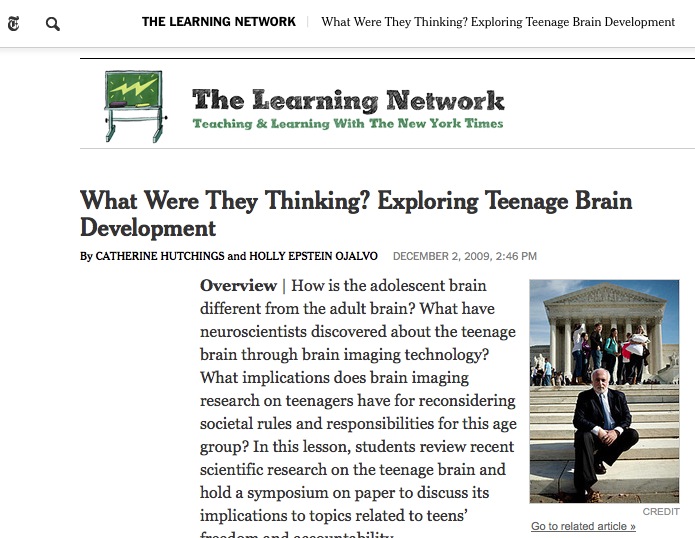This New York Times’ lesson plan was created to introduce students to the adolescent brain. By the end of the lesson, students should be able to answer the lesson’s guiding question: What implications does brain imaging research on teenagers have for reconsidering societal rules and responsibilities for this age group?
Developed by: Teaching and Learning with the New York Times | The Learning Network
Audience: Educators and students grades 9-12
Potential Use: Classroom activities
This is a lesson plan designed to be used with grades 9-12 in a classroom. The guide provides a basic overview with several different options for extension activities and additional readings, therefore it can be adapted to meet the needs and time constraints of a particular classroom.
Overview
In this lesson plan, students watch several video clips about recent scientific research on the teenage brain, as well as reading New York Times interviews with leading neuroscientists. Students are then asked to hold a mini-symposium on the adolescent brain and behavior, applying what they have learned to the lesson’s guiding question: What implications does brain imaging research on teenagers have for reconsidering societal rules and responsibilities for this age group?
The lesson includes various suggestions for going further: additional reading and videos, holding rotating “conversations on paper,” learning more about imaging technology, learning more about teen health issues related to adolescent brain development, conducting a survey with classmates on the question, “When should a person be considered an adult?”
Good to know: a Road Map to this Resource

The overview of the lesson can be read quickly. However in many instances the instructions provide suggestions only, so set aside time to choose specific activities, additional readings and activities to fit the needs of a group of unique students. The authors do not provide any guidance on the timing of activities. We estimate that the lesson can be completed in two to five days.

None required.

The lesson plan includes an overview, materials list, warm-up activity, related activity with discussion questions, main activity, suggestions for going further, and a list of standards covered (from McREL Content Knowledge – Online Edition). Links to videos and articles needed for the main and supplemental activities are provided as text links throughout the text.

- This lesson plan appeared in The New York Times in December 2009. Several links no longer work, but this does not diminish from the ways this lesson pushes students to think deeply.
- Note that to view the suggested video of scientist Silvia Bunge from Science Today in the Warm-Up section, you must have Adobe Flash Player installed.

FRONTLINE Video: The suggested FRONTLINE video is part of a six-part series on the adolescent brain. You may wish to view additional sections of the series.
How does this align with student-centered learning research and practice?
The Students at the Center framework emphasizes the importance of helping students to understand how learning takes place in the brain as a strategy to increase motivation. This lesson plan helps students think through deep issues related to scientific understandings of the teenage brain and the societal implications. They will explore questions such as: How is the adolescent brain different from the adult brain? What have neuroscientists discovered about the teenage brain through brain imaging technology? What teen behaviors do researchers suggest are connected to differences in the prefrontal cortex of the adolescent brain? The science presented to students aligns with the most current research which is presented in the research overview conducted for Students at the Center, Mind, Brain, and Education, and relates to the SATC Framework, especially the Personalized Learning and Student-Owned Learning tenets.
